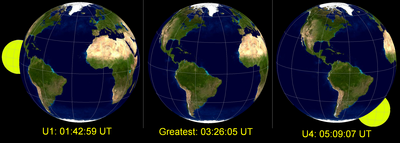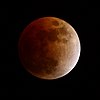Total lunar eclipse
2008/2/21 [1]
|
| Saros (member) |
133 (26)
|
| Recent |
<S <T < > T> S>
|

Telescopic view from North Billerica, Massachusetts at 3:25 UT, near greatest eclipse.
|

The Moon passes right to left through the Earth's southern shadow
|
| Gamma[1] |
-0.3993
|
| Duration (hr:mn:sc)
|
| Totality |
49:45
|
| Partial |
3:25:27
|
| Penumbral |
5:38:58
|
| Contacts
|
| P1 |
0:36:37 UTC
|
| U1 |
1:43:18 UTC
|
| U2 |
3:01:09 UTC
|
| Greatest |
3:26:03 UTC
|
| U3 |
3:50:54 UTC
|
| U4 |
5:08:45 UTC
|
| P4 |
6:15:35 UTC
|

At descending node in Leo
|
A total lunar eclipse occurred on the evening of Wednesday, February 20, and morning of Thursday, February 21, 2008. It was visible in the eastern evening sky on February 20 for all of North and South America, and on February 21 in the predawn western sky from most of Africa and Europe.
The total lunar eclipse is the first of the two lunar eclipses in 2008, with the second, the August 16, 2008 event being partial.[2] The next total lunar eclipse will occur on December 21, 2010.
Viewing
The eclipse was visible in the eastern evening sky on February 20 for all of North and South America, and on February 21 in the predawn western sky from most of Africa and Europe.

These simulated views of the Earth from the center of the Moon during the lunar eclipse show where the eclipse is visible on Earth.
|
The penumbral eclipse began at 00:35 UTC (February 21), and ended at 6:17. A partial eclipse existed from 1:43 until 3:00, followed by 51 minutes of totality (3:00 - 3:51), and then partial again from 3:51 until 5:09. (For local times, see Timing.)
It is possible to mistake the appearance of partial eclipse as the moon being in a different phase, but the shadow from the eclipse changes much more rapidly.[3]
The bright star Regulus of Leo and the planet Saturn were prominent very near the moon during the total eclipse portion. Shortly before the eclipse began, Regulus was occulted by the moon in parts of the far Southern Atlantic ocean and Antarctica.
Relation to other lunar eclipses
This lunar eclipse is part of series 133 of the Saros cycle, which repeats every 18 years and 11 days. Series 133 runs from the year 1557 until 2819. The previous eclipse of this series occurred on February 9, 1990 and the next will occur on March 3, 2026. [4] [5] [6]
It is the 6th of 21 total lunar eclipses in series 133. The first was on December 28, 1917. The last (21st) will be on August 3, 2278. The longest two occurrences of this series (14th and 15th) will last for a total of 1 hour and 42 minutes [7] on May 18, 2152 and May 30, 2170.
It is the fourth of five Metonic cycle eclipses, being separated by 19 years:
- February 21, 1951 - penumbral (Saros series 103)
- February 21, 1970 - partial (Saros series 113)
- February 20, 1989 - total (Saros series 123)
- February 21, 2008 - total (Saros series 133)
- February 20, 2027 - penumbral (Saros series 143)

The moon's path through the earth's shadow near its descending node progresses southward through each sequential eclipse. The fourth and fifth are total.
|
Timing
The moon entered the penumbral shadow at 00:35 UTC, and the umbral shadow at 1:43. Totality lasted for 51 minutes, between 3:01 and 3:52. The moon left the umbra shadow at 5:09 and left the penumbra shadow at 6:17.[8]
Total Lunar Eclipse [9]
| Event
|
North and South America
Evening of February 20, 2008
|
Europe and Africa
Morning of February 21, 2008
|
AKT
(-9h)
|
PST
(-8h)
|
MST
(-7h)
|
CST
(-6h)
|
EST
(-5h)
|
AST
(-4h)
|
GMT
(0h)
|
CET
(+1h)
|
EET
(+2h)
|
| U1
|
Partial began
|
16:43
|
17:43
|
18:43
|
19:43
|
20:43
|
21:43
|
01:43
|
02:43
|
03:43
|
| U2
|
Total began
|
18:01
|
19:01
|
20:01
|
21:01
|
22:01
|
23:01
|
03:01
|
04:01
|
05:01
|
|
|
Mid-eclipse
|
18:26
|
19:26
|
20:26
|
21:26
|
22:26
|
23:26
|
03:26
|
04:26
|
05:26
|
| U3
|
Total ended
|
18:51
|
19:51
|
20:51
|
21:51
|
22:51
|
23:51
|
03:51
|
04:51
|
05:51
|
| U4
|
Partial ended
|
20:09
|
21:09
|
22:09
|
23:09
|
00:09
|
01:09
|
05:09
|
06:09
|
07:09
|






























